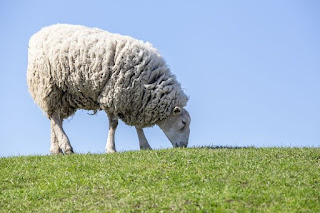SHEEP
The various breeds of sheep which occur in West Africa, such as the Fulani or Ouda, the West African Dwarf and the Y'ankasa, are rarely given any special attention by their owners and are frequently left to forage for themselves. They appear to be tolerant to trypanosomiasis but the Ouda breed, in particular, is liable to infection by internal parasites and is not suited to the higher rainfall areas.
The hairy coats of West African sheep enable them to adjust themselves to temperature variations by a loss of body heat but it also provides an adequate protection against solar radiation.
Attempts to improve the productivity of the West African breeds of sheep have been generally disappointing and efforts to improve the management by enclosing them in paddocks have frequently resulted in high levels of mortality from disease. Sheep are able to survive on a varied diet of grasses, leaves and miscellaneous organic waste products but somef response to improved levels of nutrition has been observed. Their growth rate is often variable, due to the fact that their dry season diet is limited and generally lacking in nutritional value.
UNDER EXPERIMENTAL CONDITIONS, sheep have been found to respond well to feeds which include groundnut haulms and sweet potato leaves, with the addition of ground maize, sorghum or rice bran and groundnut cake or other residues from oil extraction processes.
Salt licks and a regular supply of water should also be provided for animals kept on pastures, particularly in the dry scason.
Also Read:
Cattle (CALF REARING, FEEDING AND HOUSING)
GOATS
The goat population in West Africa is high but, as with sheep, no rcally effective mecans of improving the productivity of goats by raising the standards of management have yet been found to be practicable.
The various breeds, such as the Sokoto Red, the Kano Brown, the Bornu Red, the Bauchi and various dwarf oreeds are found in many parts of Nigeria but they vary widely in their productivity and adaptation to their environment, Most breeds of goat are well adapted to browsing and foraging on crop residues and waste organic materials, they are also noted for their ability to browse on a wide range of plants used for hedges as well as on natural hedgerow vegetation. They appear to be well adapted to survive on vegetation and residues with a low nutritional value, particularly during the dry season.
Most breeds of goat appear to be tolerant to trypanosomiasis although they generally thrive best in the lower rainfall areas of the savannas.
THE FEEDING
habits of goats are somewhat different from those of both sheep and cattle, and goats are often herded together with sheep or cattle.
If the goats are to be restrained within fences, a stout barrier will have to be provided, preferably of chain-link with stout uprights.
HOUSING
Goats kept on an extensive range system require shade from the sun and dry shelter at night or during wet weather. In general, they are likely to contract pneumonia or other respiratory diseases when closely herded in poorly ventilated conditions; this is probably the main reason for the absence of fully intensive management systems for goats.
Two types of shelter may be provided, huts for relatively small numbers or a series of stalls for larger herds.
These may be oblong or round, with mud or concrete walls and a thatched or galvanised iron sheet roof. The walls are up to 2 m in height with flooring of rammed earth or clay. Good ventilation is essential and several windows should be provided, as well as a door 1m wide. Each animal should be allowed at least 1m of floor area.
HUTS SHEDS
For larger herds, numbering 100 or more animals, goats may be kept for part of the day in stalls or pens of tubular piping within a covered barn or shed with walls 1.5 m in height.
The floor should preferably be of concrete, sloping to a rear drain.
Individual stalls may be separated by partitions and bedding may be supplied if necessary. A building measuring 220 m should accommodate 100-120 animals. Each stall should have feeding boxes and water troughs and salt licks should be available. This semi-intensive system is not commonly used, since the value of the meat produced is unlikely to justify thevcapital investment.
FEEDING
An adequate area of pasture land is essential for grazing and an adult goat may consume 0.9-1.9 kg per day of leguminous fodder such as groundnuts, cowpea or soya bean haulms. Nursing females may be given 2.3-3.6 kg per day of this type of fodder but a mixture of equal parts of crushed guinea corn and groundnut cake at a daily ration of 0.2-0.5 kg should be given in addition if the fodder is of low quality.
Pregnant females and milk goats require up to 0.5 kg per day of concentrate and fattening animals should be given a ration of up to 0.8 kg per day of concentrate.



